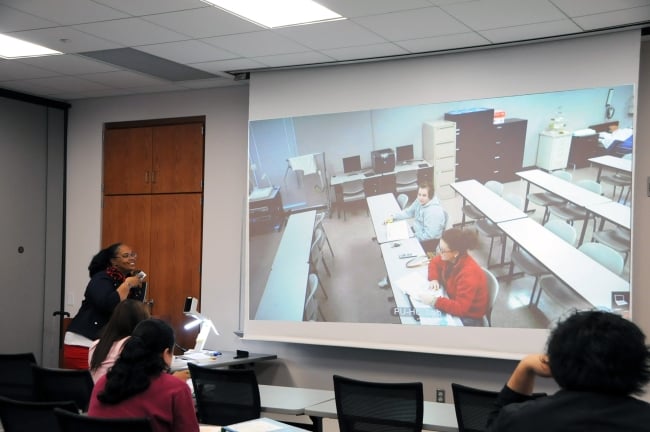You have /5 articles left.
Sign up for a free account or log in.

Fredia Wimsatt, a health care instructor at Central Georgia Technical College, teaches a blendflex course.
Central Georgia Technical College
At most institutions, a face-to-face class is conducted face-to-face, and an online class is conducted online. In blended classes, instructors mix elements of both, though students are generally expected to attend scheduled class sessions.
But maybe there’s (yet) another way. Enter blendflex, an alternative mode pioneered at the two-year Central Georgia Technical College, and hyflex, an equivalent mode with a different name at the University of St. Thomas, in Minnesota. Each class in the blendflex mode has face-to-face, synchronous online and asynchronous online experiences running simultaneously. Students can choose to attend as many or as few face-to-face sessions as they want, and complete the rest of the course online with no penalty.
“They can seamlessly at any time during the semester move back and forth within that course delivery,” said Carol Lee, director of educational technology at Central Georgia Technical College.
The mode may have originated with Brian Beatty, now associate vice president for academic affairs operations at San Francisco State University, who called his new mode "hyflex" when he conceived it in the mid-2000s. Last summer, the University of St. Thomas piloted a course in that mode, which is identical to blendflex at Central Georgia Technical. Each institution told "Inside Digital Learning" it hadn't previously been aware of other institutions hosting courses in that mode. According to Beatty, approximately 20 institutions have experimented with variations on this learning mode.
Origins
In Georgia, the idea for this model came from a blended learning course that Lee took at the University of Central Florida in 2013. The Georgia institution has one of the highest percentages of Pell Grant-eligible students of any in the nation, and many students had complained in recent years about struggling to assemble reasonable course schedules due to issues of transportation, child care and housing instability.
Hoping to improve access for those students, Lee and Bonnie Quinn, director of institutional effectiveness, applied for the U.S. Department of Labor’s Trade Adjustment Assistance Community College and Career Training (TAACCCT) grant and came up with the “blendflex” term -- a tongue twister that sums up the model’s appeal.
The health-care department was Central Georgia Technical’s first program to offer blendflex courses, but the format has been so popular among students and instructors that other departments, including math and English, are now requesting it, Lee said. The institution now teaches 20 courses in this mode and plans to increase that number by five to 10 this year.
At first, blendflex classes had a maximum enrollment of 30 students, but as they grew more popular, the institution doubled that number, simultaneously allowing instructors to count a fully enrolled blendflex course as two courses in their contract time.
St. Thomas launched its own flexible course model in a trial run last summer, just a few months after the institution decided to offer undergraduate courses in online and blended formats during the summer for the first time. According to Glori Hinck, an instructional designer at the institution's Minneapolis campus, high demand for the course and its flexible format (which had 38 students despite an original cap of 30) means the instructor will allot 60 seats next time.
"Students loved the flexibility," Hinck said. "Even those who didn’t really partake of the flexibility loved that they have the option."
Benefits
Videoconferencing puts students in blendflex courses if they choose to attend synchronously, and recorded lectures are available online for all sessions. The setup allows students across the Georgia institution’s 11 county service areas to attend classes at any of eight campuses.
Giving students freedom to choose the course mode also accommodates a wider variety of learning styles, Lee said.
“We teach universal design … but you truly don’t think about all the different learners you actually have in that class,” Lee said. “Some want to be very engaged with the teachers; others don’t want to be engaged with the teachers.”
Quick Tip
Administrators at the Georgia college allow instructors of blendflex courses to record grades only in the institution’s “gateway system,” rather than transferring grades from Blackboard, which would be more time-consuming, due to the different course registration numbers involved in blendflex courses.
Though blendflex might sound like more work for instructors -- constructing a full face-to-face course and a full online course -- Lee said she finds the mode “a lot easier” than teaching the same course in two or three different modes simultaneously.
"With blendflex, I have one section with one Blackboard shell and all my assignments, emails, discussions and course materials are the same for the blendflex class and are all located in this one class section, and [it] is so much easier to manage and maintain," Lee said. "Where I had 35 students in three classes, I now have 105 in one class."
Instructors interested in teaching blendflex courses at Central Georgia Technical must take a nine-hour professional development course taught by Lee that’s itself delivered in blendflex mode, with three face-to-face sessions and an online option. Topics include the basics of blendflex, classroom management tips and technology, including the learning management system and lecture capture.
At St. Thomas, the hyflex course required instructor James Shovein to quickly adapt to new tools including Proctorio, Zoom, Panopto and smartboards, and to adjust to having students operate in several modes at once.
"Choosing the instructor or offering this option to an instructor who is capable and qualified and willing [is critical]," Hinck said. "It’s a lot to juggle."
Challenges
Most students aren't familiar with blendflex when they arrive at Central Georgia Technical; choosing a course without having to select a corresponding modality can be jarring at first. The institution has worked the concept into its orientation and trained student advisers to explain the approach.
The mode requires students to account for their own learning styles and schedule preferences, according to Fredia Wimsatt, an instructor of health sciences core who was among the first at the institution to teach in the blendflex mode. If they miss assignment deadlines by two weeks, they receive a warning; if they offend again, they're removed from the course.
Thus far, blendflex has been a better fit for entry-level courses than for more specialized material at the upper level, Wimsatt said.
"There's state-mandated hours they have to attend," Wimsatt said. "The flexibility is not as lenient once they're in their programs."
Lee’s team is working on a short-term project to caption all blendflex courses, an effort that could cost up to $40,000 for spring 2018 alone, and more as blendflex grows.
St. Thomas is experiencing more growing pains as hyflex gets off the ground. The successful course last summer took considerable planning and effort to pull off, said Hinck, who thinks some instructors might be better suited to the time and energy demands of the format than others.
The hasty development period meant that the asynchronous online components were less dynamic than Hinck prefers, and therefore not equivalent to the face-to-face or synchronous online options. Future courses in the mode may offer only face-to-face and synchronous options, Hinck said.
Results
Students at Central Georgia Technical have been more successful in blendflex courses than in comparable courses in other formats, according to extensive data the team collected as part of the grant requirements.
Between summer 2014 and fall 2017, 40 percent of blendflex students were admitted to a competitive health program, compared with 28 percent of students in a non-blendflex comparison group. Eighty-three percent of blendflex students earned at least a C grade, just above the 81 percent success rate for the non-blendflex group. Mean GPA and average credits earned were also higher for blendflex students than for the comparison group.
Qualitative results were similarly encouraging. Ninety-five percent of students said they liked the flexibility of the format, and 98 percent said they like being able to switch methods of attendance any time their schedule demands.
Quick Tip
For faculty members interested in experimenting with hyflex/blendflex, Beatty recommends adding an online option for just one or two weeks of a face-to-face course, and then gradually scaling up.
In general, according to Lee, students tend to come to class more in the first few sessions than in later parts of the semester, when their schedules are busier and they’ve gotten a sense of the flow of the course. The online option also accommodates students who experience midsemester emergencies like a military deployment or chemotherapy, as well as nonemergencies like a honeymoon. Faculty members also use the model to their advantage when they experience late-breaking issues, according to Wimsatt, who posted lectures online after her father-in-law passed away.
Though most students shift between various formats throughout the semester, a few students opt to take the entire class in person or online, according to Wimsatt.
While students posted grade point averages that were roughly comparable to previous semesters in the traditional format, Hinck from St. Thomas said the dispersion of grades from A to F was wider than usual. She's not sure what accounts for that difference; future hyflex courses may provide more insight.
Still to Come
St. Thomas is still perfecting its approach to hyflex but sees promise in the model. In the meantime, other institutions, including Georgia Northwestern Technical College, have taken notice and requested primers or visits on the blendflex model.
"When you allow students an opportunity to decide how they learn best, the chances of them being successful are increased greatly, because it's based on their decisions, their individuality," Wimsatt said. "When they have that opportunity, they do excel."




